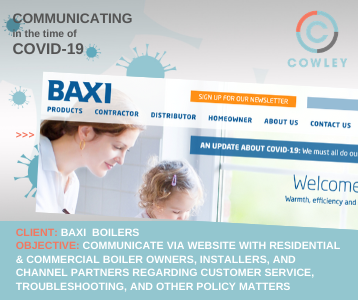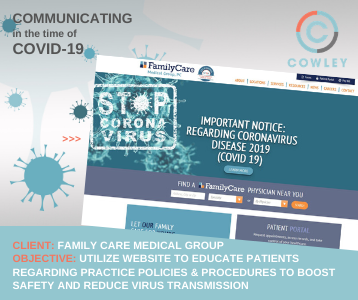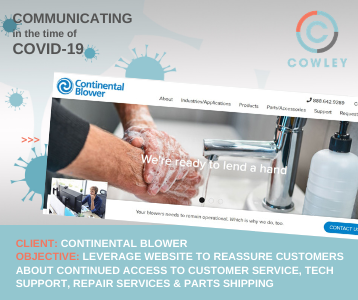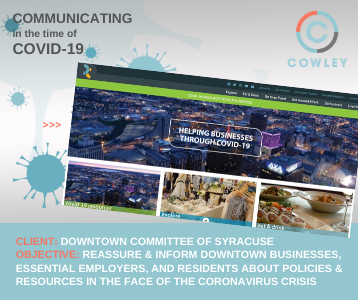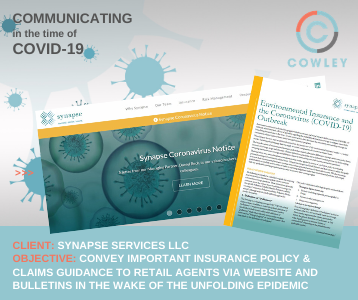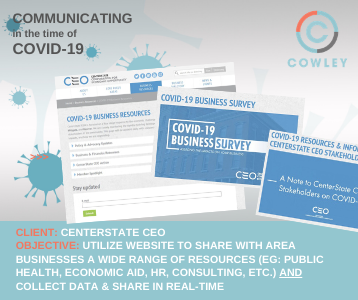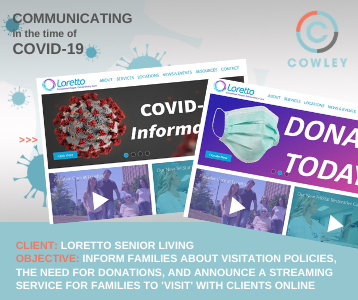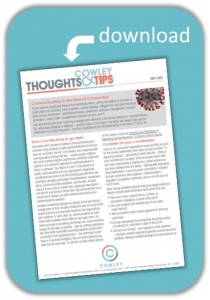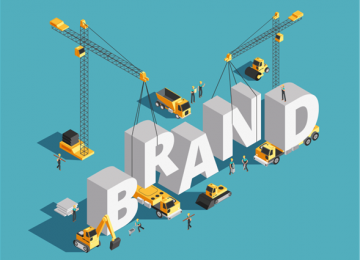Communicating in the Time of COVID-19
Not least among the areas requiring management's attention is the broad category of communications. So, while each situation is different -- and the scope of this topic is far wider and deeper than can be addressed in a single blog post -- here are 4 guideposts for communicating in the time of COVID-19. Now's not the time to go dark.Even before NYS Governor Andrew Cuomo and Kentucky's Governor Andy Beshear so aptly demonstrated the enormous value of consistent, honest, cool-headed, and compassionate communication at times like this -- modern public relations and crisis communications practitioners uniformly cautioned against a "no comment" approach to communications in times of upheaval. One reason for this? In the absence of astute communication from an organization's leadership, constituents are prone to fill the resulting gap with their own potentially damaging messages (misinformation, resentment, vitriol, consciously false narratives, and the like). Another reason? If you come to a dead stop, audiences important (if not vital) to you during normal days may conclude they've no choice but to replace you with someone else during your communications blackout. Another compelling rationale for staying on the grid during emergencies or their resultant downturns may be found in the ample empirical and anecdotal evidence that organizations who continue, or even ramp up, communications at such times tend to weather them better or even gain share. So, while you may be pondering shrinking your communications budget for the sake of austerity -- btw, an entirely understandable idea when faced with mounting payables and the grim possibility of furloughing workers -- the seemingly sound reason of austerity budgeting may not be the panacea you seek over the long haul. To cite two of many salient articles on the subject, check out Roaring Out of Recession or Marketing During Recession: To Spend or Not to Spend. Consider all your constituents.Crisis or no, successful organizations know and fully account for the myriad stakeholders who make success possible. To apply the concept -- particularly in times like this -- think of your constituencies as layers of the proverbial onion, with each layer representing a slightly-less-critical audience as you move outward from the center... Starting with employees (and shareholders, if you're a public corporation), followed by loyal customers, then suppliers, channel partners, regulators, prospective customers, and so on until you run out of layers. Next, having identified and prioritized your target audiences, deeply consider what information each needs from you.
A final word about why we ID'd employees as the first audience to bear in mind: First, if and when business returns to some semblance of "normal," you will want well-trained and loyal employees back in the fold, ready to go, and grateful for how you treated (and communicated with) them during the dark days -- rather than attempting to restart your business with the additional headwinds of a weeks-long recruitment campaign, as you struggle to find and on-board new employees. Second, with few exceptions, employees are your face to the customer. Treat them right when the going gets tough, and they'll speak well of you to your second-most-important-audience: Loyal customers. Seek out the silver linings.Necessity is the mother of invention. Every problem is an opportunity. When life gives you lemons... Whatever the aphorism -- and however trite they may seem in the face of layoffs, lost business, or bankruptcy -- the simple truth is crises can force you to think of new ways to market your products/services, diversify, or reinvent your business entirely in order to keep the lights on. Indeed, examples abound during the current coronavirus pandemic. From distilleries turning on a dime to hand-sanitizer production; to bars, restaurants, grocers, and pharmacies ramping up online orders and offering curbside service; to medical practices and mental health agencies pivoting to telemedicine; to a donut shop leveraging the likeness of Dr. Fauci... Well-led organizations are rising to the extraordinary challenges facing us with equally extraordinary innovations. And do an exemplary job of informing the world about their new ideas, products, and services. During times of crisis, still other opportunities may be found in good corporate citizenship. Noting that, given the social-distancing requirements of the current epidemic, ordinary outpourings of physical support and volunteerism has been necessarily constrained, we've seen exemplary instances of civic duty here in our own region during the coronavirus outbreak, among them Dunkin's $5,000-worth of gift cards donated to the medical staff at Upstate Medical University, Harbour Freight Tools' donation of inventoried PPE to area hospitals, and the MetLife Foundation's generous cash donation of $100,000 to the Food Bank of CNY. Not only can such activities generate valuable and low-cost publicity, positive word-of-mouth, and brand reinforcement at a time when marketing dollars can be scarce -- more importantly, they provide genuine help to the community, foment internal pride, and can afford excellent and meaningful team-building exercises (even remote ones!) at a time when employee morale can be strained. Finally, don't try to be a "health expert" if you're not!Assuming you will take, or already have taken to heart, the notion that communicating during the COVID-19 crisis is a worthwhile activity, take it from us you needn't fill your emails, website, social posts, or other coronavirus-era communiques with lengthy descriptions related to the virus itself. Not only would it be a major time-waster to attempt characterizing the threat (aka: What is coronavirus? How is it transmitted? What are its symptoms? How does one prevent contracting it?) -- significant liabilities might result from formulating your organization's own take on the subject. So restrict your messaging to matters within your purview, and refer all technical, medical, prescriptive, policy, and procedural content to widely accepted, fully qualified, and external health experts. (When in doubt, conclude your coronavirus updates and communications with a cut and paste of this simple, safe, and smart language: For more information on COVID-19, visit the United States Centers for Disease Control and Prevention.) Hope this is helpful, good luck, and be safe and smart out there! |
Stay InTOUCHSign up here to get our monthly newsletter and blog updates. |


